Outreach K12
GIFT is a collaborative effort between UGA and Georgia Institute of Technology designed to enhance mathematics and science experiences of Georgia teachers and their students. The GIFT program provides educators with a first-hand exposure to scientific research through summer intership placements.To maximize the impact of the program, teachers, with the help of their research mentors, also develop an implementation plan to integrate aspects of their experience into their classroom teaching. To learn more about the program, please see here
Summer 2008: Dale Autry, Athens Clarke Central High School
Dale designed and built a low-cost LED-based autocorrelator as his intership project. The series of pictures shows Dale constructing the system and then overseeing his AP physics class as they perform a pulse duration measurement during a field trip to our laboratory.

Dale machining components for the autocorrelator.
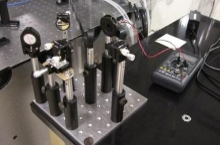
Completed autocorrelator.
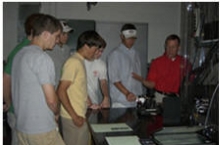
Dale's AP physics class on a field trip to our research lab to take an autocorrelation measurement.
Summer 2011: Dale Autry, Athens Clarke Central High School
During his summer internship Dale further improved the efficiency of
the hollow-core fiber DUV generation setup (constructed by James
Waugh, see below) for use in our pump-probe experiments.
Summer 2013: Ron Kidd, Elbert County High School
Ron constructed a wire-guided, gravity-fed thin film sample jet for
use with the lab's UV transient absorption spectrometer.
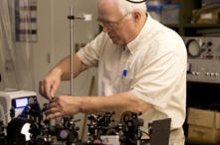
Ron preparing his setup for test measurements on indole in water.
The UGA Young Dawg Science Program places middle and high school students into research internships.
Summer 2010: James Waugh, Athens Academy
James constructed an optical system for deep ultraviolet generation
in an argon-filled hollow-core fiber.
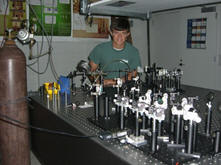
James aligning the fiber setup.
Lead by Mr. Barker, outreach professional at the University of Warwick, Profs. Ullrich and Stavros performed 14 “flashes and bangs” science shows at middle schools in the Athens area to more than 1500 students during September 2010-2012. These lectures covered some fundamental principles of chemistry and physics, accompanied by impressive displays of loud bangs and explosions, but also extended into more advanced topics such as scientific research on the photostability of DNA as currently in progress in our ultrafast laser spectroscopy laboratory. These shows were funded through a NSF International collaboration in Chemistry grant.
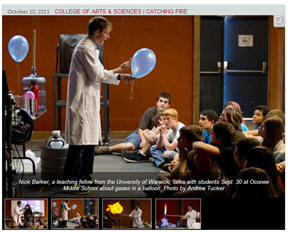
Mr. Barker in action during one such demonstration as he explains the properties of gases; the series of smaller pictures shows demonstrations performed by Profs. Ullrich and Stavros.